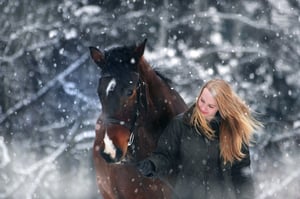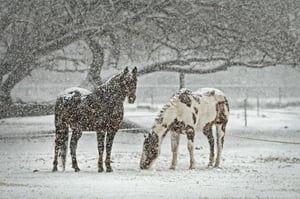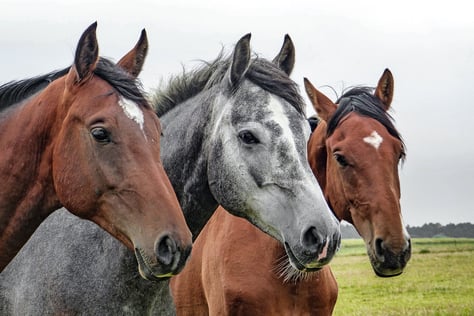Riding in the snow is one of winter’s joys and is a nice change of environment for your horse. But if this is his first experience with snow, how will he react? It’s a different surface for him. It looks different and it feels different – this can be spooky for some horses. If it’s merely a dusting of snow, this might not be an issue. But once snow reaches his knees, it becomes a whole new experience.
 There are two kinds of snow: soft and fluffy or packed and icy. “Powder”, the soft, fluffy snow, is ideal for riding due to its even smoothness on trails. However, it can take more effort for your horse to push his legs through it. It’s just as important to give your horse a thorough warmup before riding in snow. This can help prevent sore muscles later. Know where you are riding as powdery snow can also cover hazards such as large rocks or tree stumps.
There are two kinds of snow: soft and fluffy or packed and icy. “Powder”, the soft, fluffy snow, is ideal for riding due to its even smoothness on trails. However, it can take more effort for your horse to push his legs through it. It’s just as important to give your horse a thorough warmup before riding in snow. This can help prevent sore muscles later. Know where you are riding as powdery snow can also cover hazards such as large rocks or tree stumps.
Packed snow is when you are following a trail made by someone else – another horse, a skier, a snowmobile. Because it’s flat, it takes less energy for your horse to walk through it, but packed snow can also turn icy so be aware of the possibility of your horse slipping. Due to the sun and shade provided by trees or other structures, a trail can have stretches of powder AND patches of ice that can come up unexpectedly.
Watch out for “ice balls” that can accumulate in  your horse’s hoofs. When your horse walks on snow, the heat of his hoof can warm up the snow while at the same time the metal of the horseshoe can cause it to freeze up again, resulting in a buildup. After a while, this turns into an uneven mass that can cause your horse discomfort when walking and possible damage to tendons and joints. There are several ways to help prevent this problem. They include letting your horse go barefoot, using hoof boots or adding anti-snowball pads.
your horse’s hoofs. When your horse walks on snow, the heat of his hoof can warm up the snow while at the same time the metal of the horseshoe can cause it to freeze up again, resulting in a buildup. After a while, this turns into an uneven mass that can cause your horse discomfort when walking and possible damage to tendons and joints. There are several ways to help prevent this problem. They include letting your horse go barefoot, using hoof boots or adding anti-snowball pads.
Have a happy New Year! And make the most of the long winter ahead with a safe ride in the snow.



